
Allocasuarina, commonly known as sheoak or she-oak, is a genus of flowering plants in the family Casuarinaceae and is endemic to Australia. Plants in the genus Allocasuarina are trees or shrubs with soft, pendulous, green branchlets, the leaves reduced to scale-like teeth. Allocasuarinas are either monoecious or dioecious, the flowers never bisexual. Male and female flowers are arranged in spikes, the female spikes developing into cone-like structures enclosing winged seeds.

Casuarina is a genus of flowering plants in the family Casuarinaceae, and is native to Australia, the Indian subcontinent, Southeast Asia, islands of the western Pacific Ocean, and eastern Africa. Plants in the genus Casuarina are monoecious or dioecious trees with green, pendulous, photosynthetic branchlets, the leaves reduced to small scales arranged in whorls around the branchlets, the male and female flowers arranged in separate spikes, the fruit a cone containing grey or yellowish-brown winged seeds.

Allocasuarina fraseriana, commonly known as western sheoak, common sheoak, WA sheoak. Fraser's sheoak or just sheoak, is a tree in the family Casuarinaceae. Endemic to Western Australia, it occurs near the coast in the south west corner of the State, from Jurien to Albany . The Noongar peoples know the tree as kondil.condil, kulli or gulli.

Allocasuarina huegeliana, commonly known as rock sheoak or sighing sheoak, is a tree in the family Casuarinaceae. Endemic to Western Australia, it occurs mostly throughout the Wheatbelt region. It is now especially common on road verges, where it sometimes forms thickets.

Allocasuarina humilis, commonly known as the dwarf sheoak or dwarf casuarina, is a woody shrub of the family Casuarinaceae endemic to the south-west of Western Australia.
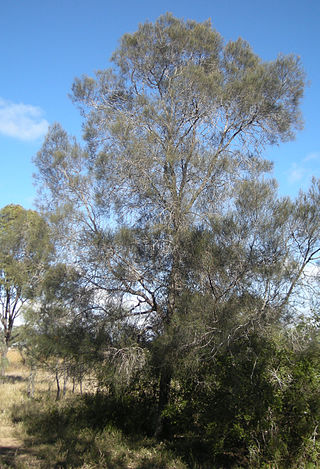
Allocasuarina luehmannii is a species of ironwood tree native to Australia and its wood is the hardest commercially available as measured by the Janka Hardness Scale.

Allocasuarina decaisneana or desert oak is a medium-sized, slow-growing tree found in the dry desert regions of the Northern Territory, South Australia and Western Australia. The Anangu peoples know the tree as kurkara.

Allocasuarina verticillata, commonly known as drooping she-oak or drooping sheoak, is a nitrogen fixing native tree of southeastern Australia.
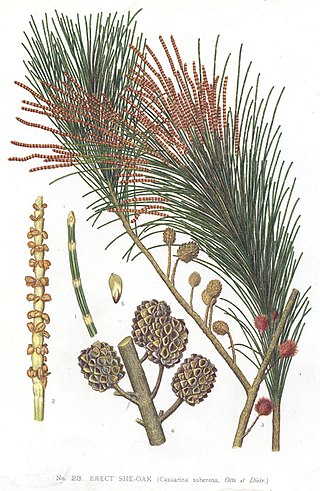
Allocasuarina littoralis, commonly known as black sheoak, black she-oak, or river black-oak, is an endemic medium-sized Australian tree. A. littoralis is named for its growth near the coast; this is somewhat misleading, as it will grow well both inland and in coastal zones. Studies have shown that in long-time unburnt coastal woodlands, A. littoralis has replaced the original Eucalyptus-dominated woodland.

Chamaescilla corymbosa, commonly known as blue stars, blue squill or mudrurt, is a tuberous perennial herb species in the genus Chamaescilla. It is endemic to southern Australia.

Acacia ausfeldii, commonly known as Ausfeld's wattle or whipstick cinnamon wattle, is a shrub species that is endemic to south-eastern Australia. It grows to between 1 and 4 metres high and has phyllodes that are 2 to 7 cm long and 2 to 6 mm wide. The yellow globular flowerheads appear in groups of two or three in the axils of the phyllodes in August to October, followed by straight seed pods which are 4 to 9 cm long and 2 to 4 mm wide.

Allocasuarina inophloia, also known as woolly oak, or stringybark she-oak, is a shrub or small tree of the she-oak family Casuarinaceae endemic to inland New South Wales and Queensland. The hairy bark is an unusual feature.
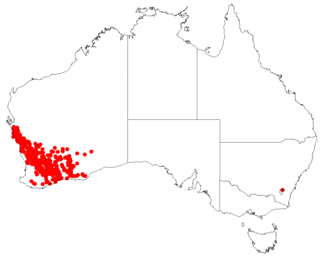
Allocasuarina campestris, commonly known as the Shrubby she-oak, is a shrub of the she-oak family Casuarinaceae native to Western Australia.
Parndana Conservation Park is a protected area in South Australia located on Kangaroo Island. It was dedicated in 1968 for the protection of remnant native vegetation.

Allocasuarina paludosa, commonly known as the swamp sheoak or scrub sheoak, is a woody shrub of the family Casuarinaceae. It is endemic to south-eastern Australia.
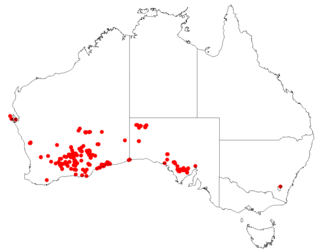
Allocasuarina helmsii is a shrub of the genus Allocasuarina native to both South Australia and Western Australia.

Allocasuarina pusilla, commonly known as the heath oak-bush or the dwarf she-oak, is a species of Allocasuarina genera native to Australia.

Velleia paradoxa, or spur velleia, is a small, softly pubescent perennial herb in the family Goodeniaceae, endemic to Australia. It is found in South Australia, Tasmania, Victoria, New South Wales and southern Queensland. It grows in sclerophyll forest and grassland. It has oval to elliptical leaves which are from 7–25 centimetres (3–10 in) long and it flowers mainly from August to February.
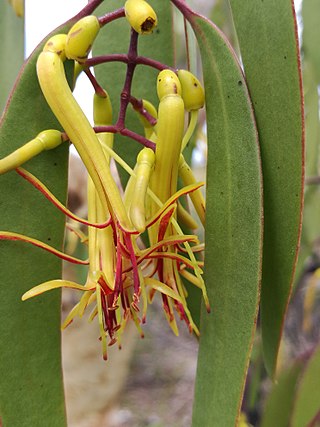
Muellerina eucalyptoides, commonly known as creeping mistletoe, is a hemiparasitic aerial shrub in the family Loranthaceae. The species is endemic to Australia.

Acacia glandulicarpa, commonly known as the hairy-pod wattle, is a perennial shrub belonging to the genus Acacia and the subgenus Phyllodinea that is native to parts of south eastern Australia.



















